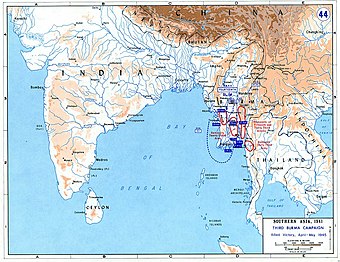
Burma campaign (1944–1945)
The Burma campaign in the South-East Asian Theatre of World War II was fought primarily by British Commonwealth, Chinese and United States forces[5] against the forces of Imperial Japan, who were assisted by the Burmese National Army, the Indian National Army, and to some degree by Thailand. The British Commonwealth land forces were drawn primarily from the United Kingdom, British India and Africa.
For action before November 1944, see Burma campaign (1944).
Partly because monsoon rains made effective campaigning possible only for about half of the year, the Burma campaign was almost the longest campaign of the war. During the campaigning season of 1942, the Japanese had conquered Burma, driving British, Indian and Chinese forces from the country and forcing the British administration to flee into India. After scoring some defensive successes during 1943, they then attempted to forestall Allied offensives in 1944 by launching an invasion of India (Operation U-Go). This failed with disastrous losses.
During the next campaigning season beginning in December 1944, the Allies launched several offensives into Burma. American and Chinese forces advancing from northernmost Burma linked up with armies of the Chinese Republic advancing into Yunnan, which allowed the Allies to complete the Burma Road in the last months of the war. In the coastal province of Arakan, Allied amphibious landings secured vital offshore islands and inflicted heavy casualties, although the Japanese maintained some positions until the end of the campaign. In Central Burma however, the Allies crossed the Irrawaddy River and defeated the main Japanese armies in the theatre. Allied formations then followed up with an advance on Rangoon, the capital and principal port. Japanese rearguards delayed them until the monsoon struck but an Allied airborne and amphibious attack secured the city, which the Japanese had abandoned.
In a final operation just before the end of the war, Japanese forces which had been isolated in Southern Burma attempted to escape across the Sittang River, suffering heavy casualties.
Background[edit]
Allied plans[edit]
As the monsoon rains ended late in 1944, the Allies were preparing to launch large-scale offensives into Japanese-occupied Burma. The main Allied headquarters for the British, Indians and Americans in the theatre of war was South East Asia Command, based at Kandy in Ceylon and commanded by Admiral Louis Mountbatten. The command had considered three major plans as far back as July 1944.[6]
Aftermath[edit]
Slim had been promoted to command Allied Land Forces South East Asia (the army component of South East Asia Command). He was replaced at Fourteenth Army by Lieutenant General Miles Dempsey. Fourteenth Army and XV Corps HQs had returned to India to plan the next stage of the campaign to re-take Southeast Asia. A new corps, the XXXIV Corps under Lieutenant-General Ouvry Lindfield Roberts, was raised and assigned to Fourteenth Army.
The next intended operation was to be an amphibious assault on the western coast of Malaya, codenamed Operation Zipper. The dropping of the atomic bombs forestalled Zipper but the operation was undertaken post-war as the quickest way of getting occupation troops into Malaya.


